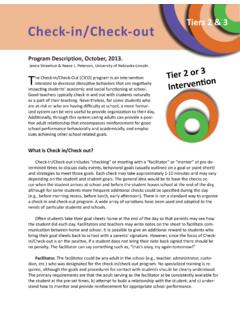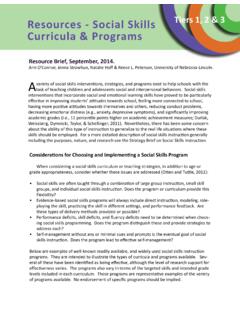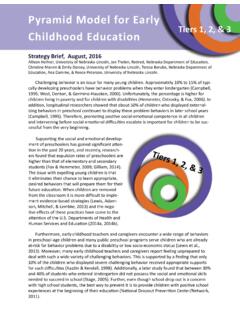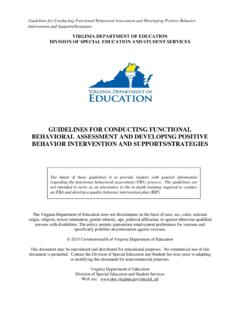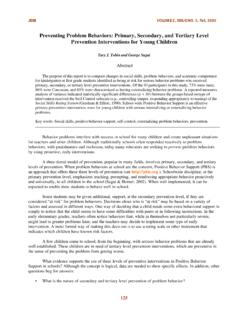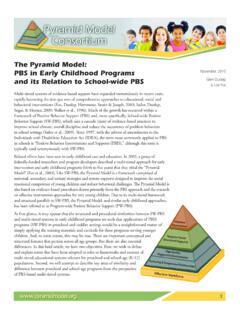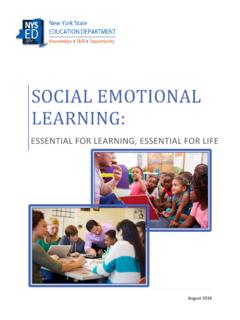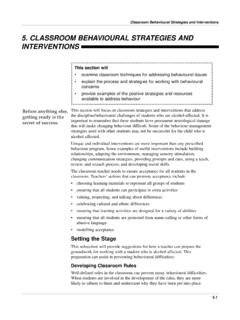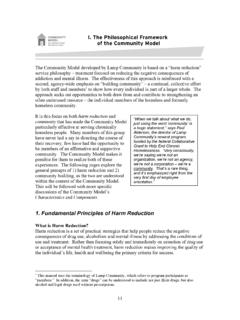Transcription of Positive Behavior Interventions & Supports
1 Positive BehaviorInterventions & SupportsTiers 1, 2 & 3demonstrated that these techniques are not effective because they do not aim to replace the punished Behavior with appropriate Behavior , they do not teach new more appropriate behav-iors, they do not reduce future incidences of the punished Behavior , and as a result of these techniques, students miss valuable instruction time (Cameron, 2006). As an alternative to these techniques, researchers have developed and begun implementing Positive Behavior Interven-tions and Supports (PBIS; Sugai & Horner, 2006). What are Positive Behavior Interventions & Supports ?PBIS is a school- wide framework for preventing, reducing, and replacing problem behav-iors. It has been implemented in thousands of schools across the nation.
2 The purpose of PBIS is to explicitly teach Positive , appropriate behaviors while creating an environment in which these behaviors are more acceptable than are other negative, inappropriate behaviors. Schools that successfully implement PBIS have the following key elements in place: A school- wide focus on the importance of a student s environment and the role it plays in encouraging or discouraging Behavior ; efforts to continuously strengthen the school climate. A team-oriented approach to planning and implementation of Interventions and procedures. A clear set of behavioral expectations and goals. The constant use of data collection and data analysis to facilitate team and staff decision making. A tiered approach to Interventions (see Three tiers of intervention below).
3 Direct, explicit teaching of appropriate student Behavior in the environments where that Behavior is expected. A consistent effort to reinforce Positive student who are unable to behave appropriately and follow school rules are unable to learn. Worse, these students may distract their peers and their teachers, decreasing the value of the classroom as a whole. Improving student Behavior has been shown to improve academic performance (Lassen, Steele, & Sailor, 2006). Schools should therefore make teaching appro-priate behaviors a priority. Schools have typically relied on traditional discipline prac-tices such as detention, suspension, and expulsion to teach stu-dents how to behave. Unfortunately, research has consistently Strategy Brief, October, 2013.
4 Scott Fluke & Reece L. Peterson, University of 1, 2 or 3 Intervention* While School- wide Positive Behavior Interventions and Supports is often identified with the acronym SWPBIS, we have chosen to use the shorter PBIS. In addition, early work on this topic may have used the PBS acronym for Positive Behavior Supports , but this abbreviation was confused with other programs, and has generally been discontinued. SWPBIS, PBIS and PBS all identify the same strategy. Building & Sustaining Student EngagementPBIS 2do systems based exclusively on punishment. Moreover, systems based on punishment may have other side effects such as students at-tempting to avoid or escape punishment ( , skipping school or cutting a class), as well as creating a negative attitude about school and a stressful learning Tiers of InterventionPBIS is based on a mental health prevention model of three tiers of intervention.
5 These tiers serve as the framework through which decisions about Interventions are made. Most often these three tiers are graphically represent-ed in a triangle diagram (see example below). However, these tiers may also be represented as concentric circles (see examples on the next page). The tiers may help prioritize the type and intensity of Interventions for Behavior that students receive. Tier 1 InterventionAll students receive Tier 1 Interventions , which are often preventative in nature and aimed at creating a Positive and reinforcing learning environment. All students benefit from What are some of the underlying principles of PBIS?Many of the techniques used in PBIS are based on behavioral research, which boasts some of the strongest evidence and outcomes across the social sciences.
6 This research has collectively shown that much of human behav-ior can be explained and modified by reinforce-ment and punishment. A Behavior is reinforced when it is followed by something good ( , praise) or by taking away something bad ( , getting out of a chore). Conversely, a Behavior is punished when it is followed by some-thing bad ( , a truly undesirable task) or by the removal of something good ( , loss of a privilege). Behaviors that are reinforced tend to be repeated more frequently in the future, while behaviors that are punished in this way tend to be repeated less frequently. This is why traditional discipline strategies often fail; they attempt to punish students with ineffec-tive consequences (for example, removing a student from school may be a desirable or re-inforcing consequence for some students, and does not teach or reinforce more appropriate behaviors).
7 Systems based on reinforcement lead to more powerful Behavior change than Tier 3 Supports Specialized Individualized Systems for students with high-risk behaviorTier 2 Supports Specialized Group Students at risk for high-risk Behavior Not responding to Tier-1 supportsTier 1 Supports School/Classroom- wide Systems for all students, staff, & settingsBuilding & Sustaining Student Engagement Systematic, consistent reinforcement, in a variety of forms, but often with only staff praise, for all students when they follow behavioral expectations. Although this reinforcement should be consistent, and all students should receive this reinforcement over a period of time, students are not to receive it every single time they comply with the expectations.
8 Teachers should be expected to reinforce appropriate Behavior at a much higher rate than they provide cor-rections for inappropriate Behavior . Establishment of a Positive school climate, wherein students respect and trust the adults in the school (see the Staff-Student Relationships Strategy Brief). Consistent, fair, and evidence-based conse-quences for when behavioral expectations are not met ( , time-out for younger stu-dents, loss of a privilege for older students, etc.).PBIS 3 Tier 1 Interventions , and it is often estimated that 80% of students will not need additional Interventions beyond those at Tier 1. However, this estimation is variable depending on the school and community. When Tier 1 interven-tions are implement well, potentially fewer students will need additional services or inter-ventions.
9 These Interventions can include but are not limited to: Establishment of a few simple, universal, Positive school expectations for Behavior ( , Be safe, be respectful, be respon-sible ). These expectations are explicitly taught to all students and are clearly posted in all classrooms, and should be understood by students. Examples of the behaviors that meet these behavioral expectations are explicitly taught for various school environments ( , in the classroom, cafeteria, playground, etc.). A concentric circle depiction of tiers of intervention as described in the Safe and Responsive Schools Framework (Peterson, Miller & Skiba, 2004) Building & Sustaining Student Engagement School- wide collection and analysis of data about Behavior , which is used to modify school procedures or make other changes.
10 For example, if a large percentage of office referrals are found to be from the cafete-ria, increasing adult supervision there may reduce future 2 Intervention Even with Tier 1 Interventions in place, some students will show signs of difficulty in complying with the behavioral expectations. Signs may include Behavior management problems in class, tardiness, office referrals, absences, etc. These students who are at risk of developing more serious Behavior problems are then identified to receive Tier 2 interven-tions and Supports . At Tier 2, Interventions are more intensive ( , they are stronger and more likely to elicit change) but also may require more resources. However, they are focused only on those students for whom data suggests are having difficulty.




